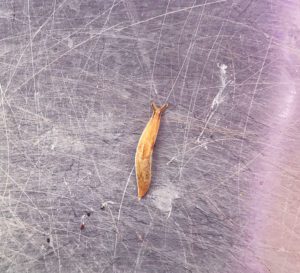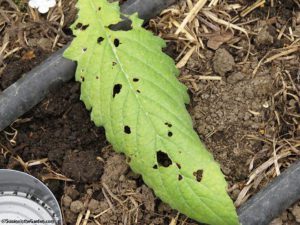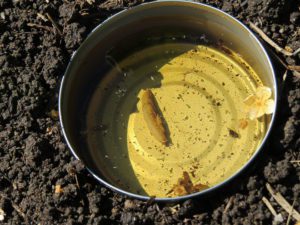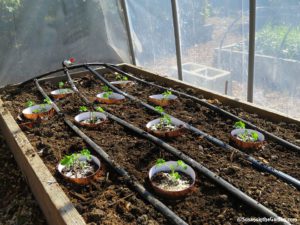Slugs
Latin name: Deroceras reticulatum
Size: Varies by region, anywhere from 1/2″ to several inches in areas with higher rainfall.
Color: Brown
Introduction: Slugs are gastropods, which literally means “stomach-foot” so they are essentially a stomach gliding along on a slimy foot. They have voracious appetites, especially for young, tender seedlings. They prefer a moist, shady environment and are nocturnal.
Life cycle: They are hermaphrodites, meaning each one has all the “equipment” necessary to produce and lay eggs. They lay their eggs in the soil; once hatched, they take 3 to 6 months to mature.
Signs of their activity: Slime trails, holes in plant leaves (refer to photo in previous paragraph). The very best way to identify that a one of them is the culprit (aside from seeing one, that is), is to spot their slime trails.
Typically seen on: (in the vegetable garden) Salad greens, beans, broccoli and other cabbage family crops, strawberries, tomatoes. In the ornamental garden, slugs particularly love hosta leaves but many other plants as well. They also feed on decaying vegetation.
Controls: If some areas of your garden are getting excessively moist, try to troubleshoot and resolve this. That will make the environment less attractive to them. Organic controls include slug traps (made with beer – refer to 2nd photo), copper bands around the base of susceptible plants (refer to bottom photo), organic slug bait, diatomaceous earth, hand-picking.
Natural predators: Ground beetles, rove beetles
Additional information: Oregon State University Snails/Slugs, University of Minnesota Slugs in Home Gardens, and University of California Integrated Pest Management Snails and Slugs. Also, Susan Mulvihill’s two blog posts: Thwarting Slugs and Dealing with Slugs.
Back to Organic Pest Control




